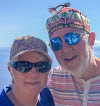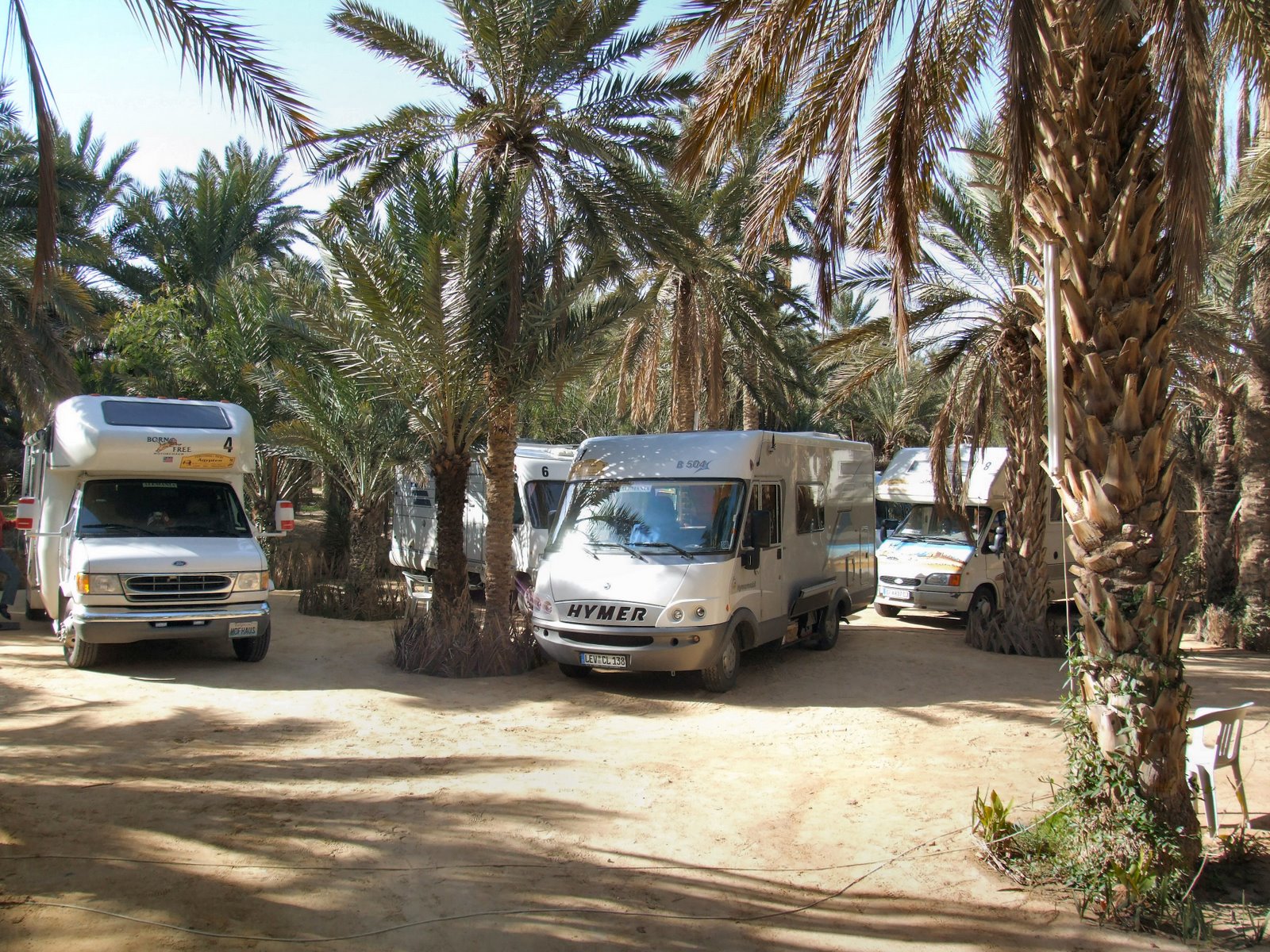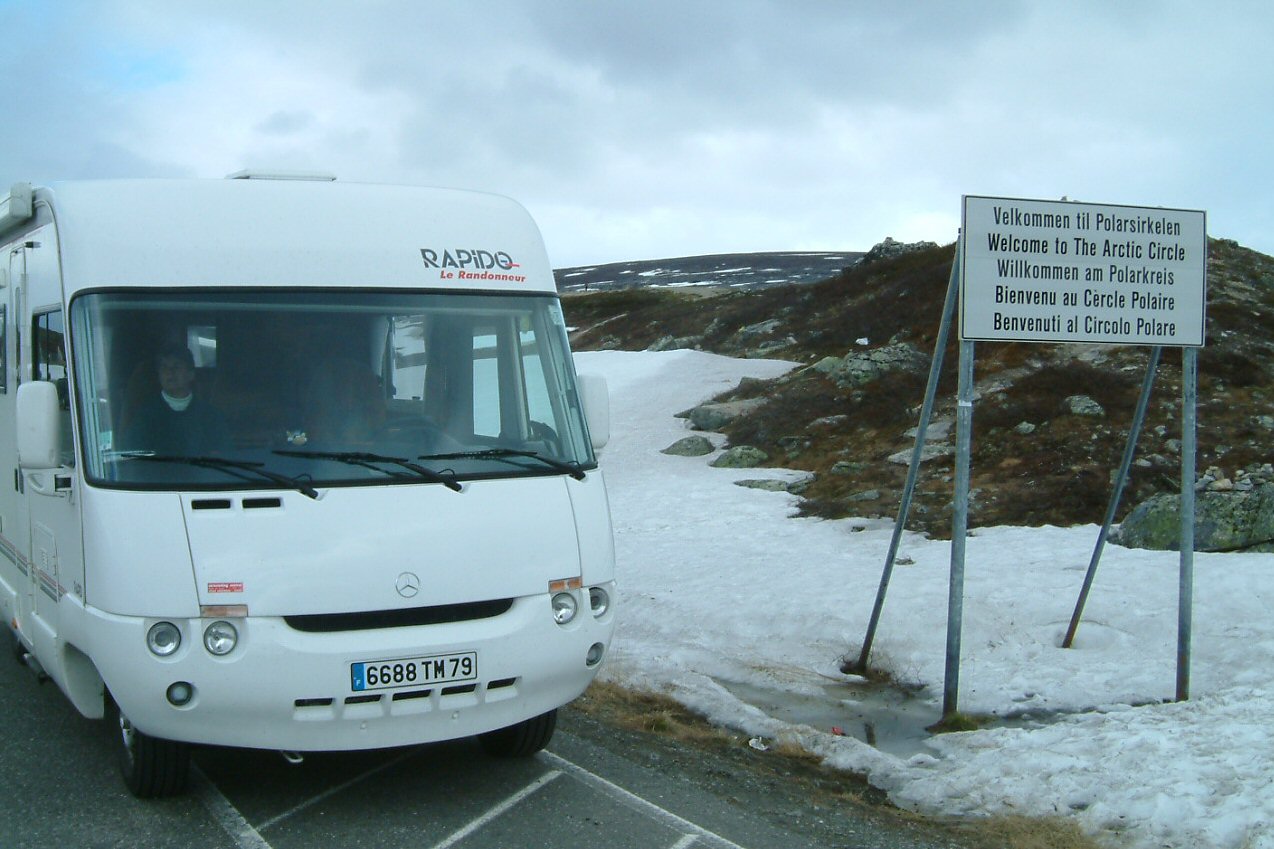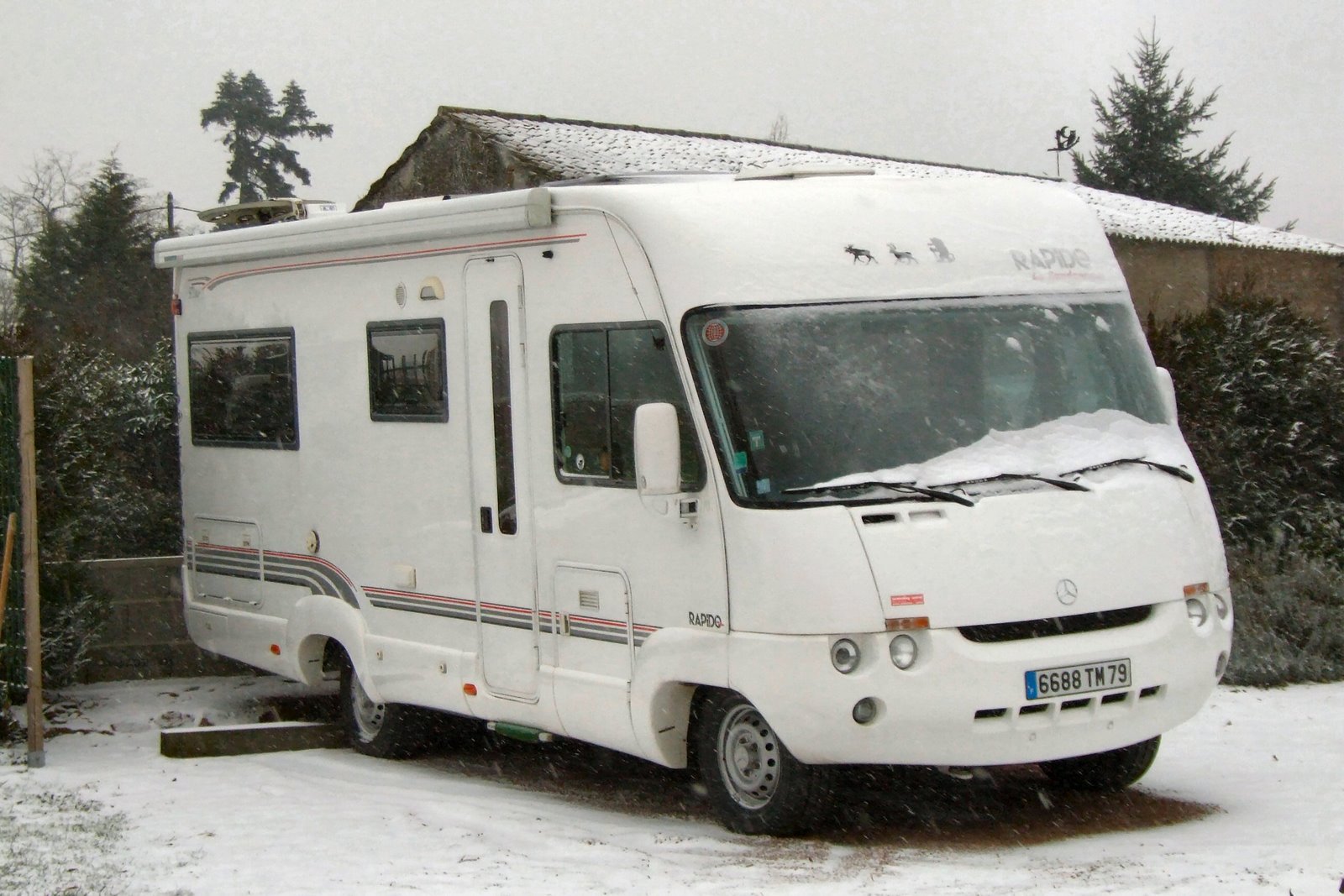The Arctic Road
What many of us call Lapland and the North Cape, the most northerly point in Europe, must be one the top ten challenges for all motor caravanners. Crossing the Artic Circle, for the first time is a truly magical event, as you enter the land of the midnight sun.
Having driven North through Finland, from Helsinki, we crossed the magic line just north of Rovaniemi. Here you will find the Santa Claus Village and Post Office. This point, 66O 33” 07’, is further north than just about anywhere, and is further east than Athens at 25O East. Most people, like us, will travel during June & July when the weather is at its “best”, with daytime temperatures between 16 & 20C and the lowest temperatures between 8 & 11C. During the winter minus 45C is not uncommon and the sun doesn’t shine at all for some weeks. The summer months also benefit from the midnight sun during June & July, but have the disadvantage that you will not get the chance to see the Northern Lights and from midsummer’s day the mosquitoes are at there worst. However whatever the weather you will find the Finnish Campsites to be of a very high standard with all the facilities you could want and more.
At Rovaniemi we camped at Ounaskoski Camping, right on the banks of the Kemijoki River, and only 15 minutes walk from the town centre and the Artikum Museum. Even though half of the museum was closed for rebuilding it was still worth a visit, the multimedia show in particular was excellent. And it only cost 4€ (£2.80) each. We camped there for 2 nights at a cost of 20€ (£14.20) per night including electricity. The price includes hot showers in a warm air conditioned block and use of the sauna. The Kemijoki, Finland’s largest river, is a deep brown colour and offers numerous opportunities for sightseeing by boat. We just had to visit the Santa Claus Post Office, as we headed north, to buy the grandchildren a special Christmas treat, a personal letter from the man himself delivered in mid December. We also filled up with diesel and it was still only costing 0.77€ (£0.54) a litre.
We were in no particular hurry and had planned to visit a few sites on the route to North Cape from Rovaniemi. The trip is about 700kms, or 450 miles, and we were going to take 4 or 5 days. Between Rovaniemi and Sodankyla we had planned to visit the Lampivaaran Jalokivitunturi, Amethyst Mountain. The main road north, the 4 (E75), is excellent, only two lanes but quite, flat and peaceful. Rather than go via Kemijarvi we hoped to get to the amethyst mine from the 972 at Torvinen. Sadly the 972 is unmade and full of potholes, we gave up after 2kms and returned to the 4. Fortunately a little way north there is another road to Luosto, where the mine is, this was made up and presented no problems. Well until we reached a T-junction with the 972 after about 15kms, where we were back on the unmade road and very heavy lorries with trailers were going in both directions at a very brisk pace. So we gave up again and never did see the mine. Perhaps the alternative route would have been better but somehow I doubt it, at some point you had to travel down a very poor unmade road.
So despite that minor disappointment we camped at Camping Sodankyla Nilimella, which is only 1km from the centre of Sodankyla, which they call the municipality of the stars. The Sodankyla Geophysical Observatory constantly surveys the earth’s magnetic field and the cosmic radio noise. In addition the upper atmosphere is radar sounded and earthquakes are measured using seismic recordings. It is also the home of the Sodankyla Light Infantry Brigade, the Finnish version of the SAS, which specialises in survival in cold climates, with temperatures of –50C in the winter they have certainly found a good home.
The campsite is only open for June, July & August but has good facilities in two blocks including saunas. On June 9th only 5 pitches were in use so there was plenty of space. Right behind reception are some good-sized pitches, clearly marked with hedges that have 10amp electricity. The somewhat unusual feature of this site is that it is split into two by a small, lightly trafficked public road. That did not present a problem and the night, with electricity and hot showers, cost 16€ (£11.20). Although you have to turn off the main road into the town on the 5 (E63) it is very easy to find and well signposted.
The next day we wanted to visit the Tankavaaran kansainvalinen Kultamuseo, the gold prospectors museum. Fortunately Tankavaaran is right on the 4 (E75) about 96kms north of Sodankyla on the way to Ivalo. Before arriving there we stopped to buy some fresh smoked from one of the many smokeries in route. A whole smoked brook trout cost 7.20€ (£5.10). Visiting the gold mine turned out to be a double whammy, as it is at the entrance to one of Lapland’s many national parks. So getting our priorities right we first went into the national park, where the smoked trout and salad made an excellent lunch. We then visited the National park centre and spent some time at the exhibition. The park offers many way marked walks of varying length and excellent opportunities to see the wildlife of the area.
So a bit later than planned we made the short trip to the Gold mine and the museum. The entrance fee of 10.50€ (£7.35) includes the cost of gold panning. The museum includes exhibits and relics from all the world’s gold fields and buildings from various countries showing the way prospecting developed. The displays were very good only to be surpassed by the gold panning experience. First you collect a pair of Wellington boots and then sit on a plank in ice cold water, thick with mud, about one foot deep. The prospector then brings the pan loaded with gold laden soil. A quick demonstration of the technique is followed by about 15 minutes of panning. At the end I had 4 spots of gold each the size of a pinhead! Still I was successful. I was assured that each year at least one lucky visitor walks away with a nugget.
Having warmed up at the adjacent fire we continued onwards towards Ivalo. More by luck than planning we stopped for the night at Ukonjarvi Camping just 11kms north of Ivalo. The site at the southern tip of Lake Inari is within a thin birch and pine forest. The pitches are excellent, many have electricity and the site has all the facilities you will want including 2 saunas. We booked the sauna at 12.50€ (£8.75) for one hour and enjoyed the heat and subsequent benefits. As it was our wedding anniversary we went to the sites restaurant for a treat. Fully licensed and only two minutes walk from our serviced pitch what more could we ask. I opted for the draught beer, Lapin Kulta, and we both had the reindeer casserole. It was great!
The next morning we set off, a little later than normal, towards Inari where we planned to visit the Sami Museum. If you are tempted to buy souvenirs along the route wait till you get to Inari, the centre of Sami culture. But first we visited the Inari Lake scenic viewpoint that is only 2kms from the campsite, despite the 1:5 climb the view and small exhibition was very worthwhile. The display includes photos of a rogue Russian cruise missile that crashed on the frozen lake Inari one winter, the old USSR being only 45kms away. Back on the route we stopped at the Bears Cave but fortunately the stairs were being rebuilt and access was not available.
We arrived at Inari just before lunch and looked at the various Sami souvenir shops. Suitable laden we had a light lunch at the Kioski that also houses the air taxi. Just as you leave Inari you will find Siida, the Sami Culture and Northern Lapland Nature Centre. Allow at least 2 hours for this visit, the indoor displays are among the best we have seen and the outdoor exhibits well worth the walk. The centre has created a fascinating information package focusing on the indigenous Sami people and the Northern seasons. You will leave the centre much wiser and fascinated by what surrounds you.
The journey to the Norwegian border continues northwards via the 4(E75) and then along the 92. The later road is a little narrower and undulates across some comparatively uninteresting countryside. The birch and pine trees are now smaller and much less impressive. Only the sighting of various wild reindeer herds breaks the journey. After 80kms you arrive at Karigasniemi, the border town where we camped at the Tenorinne campsite. Turn left just before the border and the site is on the left, along side the Karasjakka River. The fee of 16€ (£11.20) includes electricity and hot showers in a heated block. A kitchen and sauna are also available and the site is quite and reasonable mosquito free. Our logic for stopping here was it left an easy day’s journey to NordKapp of about 222kms (137 miles).
The next morning we thought our journey would begin with customs and passport checks, we forgot that Norway was not a member of the EU. To get here we had gone through 7 countries and had not stopped at any borders. This was going to prove to be a novelty. Well we were in for a surprise, as the border crossing is not permanently manned, so we just drove through the nothing to declare channel and that was it, quite an anticlimax.
The first town you arrive at in Norway is Karasjok; you’ll find a bank, with cash dispenser, just ahead of the roundabout, and a few petrol stations, a supermarket and coffee shop. The next section of the E6, which is signposted Alta, takes you to Lakselv. Along this road is a section restricted for foreigners, it is clearly marked and military police patrol the area and there were helicopters buzzing around all along the valley. By now the landscape has changed dramatically, with snow capped cloud-covered mountains on both sides and almost no trees.
At Lakesekv you are at the base of the Porsangen Fjord, a large inlet of the Artic Ocean. From here the E6 hugs the coast of the fjord, as I drove along I was thinking I must mention that this road is a bit narrow in places especially at bridges. Locals seem to drift around bends using the whole road and don’t give much space to oncoming vehicles when coming out from side roads; the numerous skid marks are testimony to the problem. Then, at a bridge, there were two not very happy car owners filling in their constat amiable as a result of a not too serious coming together. Excitement over we continued north enjoying the dramatic ever-changing scenery of the fjord. Weather sweeps in from the Artic at a tremendous speed and we had, snow, hail, sleet and rain at various times. Large lumps of ice formed on the windscreen at one point.
Just north of Russenes you go through a 3kms long, dark, winding, narrow tunnel. We entered it from bright sunshine, so it took a few minutes for my eyes to adjust, and exited into another snowstorm. Shortly after Kafjord you enter the NordKapp tunnel. Almost 7kms long, the first 3kms being a steep descent, but at least it is wider and well lit. It is interesting to think at the half waypoint that the Artic Ocean is directly above you. The toll was 445Kr (£40) for a 6m campervan and driver and 46Kr (£4.15) for each extra passenger, payable by cash or credit card at the NorthKapp side.
We had emailed ahead to the Kirkeporten Campsite, the most northerly campsite in the world, so that we had a pitch with electricity. This was a simple but unnecessary precaution as the site was very quite. We have certainly found the laptop computer, with Internet access through a mobile phone, to be a great asset on this trip.
Kirkeporten as its name suggests is a church and small fishing port in the village of Skarsvag that has about a dozen houses, and is constantly lashed by the harsh artic weather. Despite the weather we donned our two layer anoraks and climbed the hill behind the site to see NordKapp. From the top, which is not what it seems from the site, you can see the Vikings Horn, a large rock that is at NordKapp. We also spent the afternoon at NordKapp itself viewing the exhibition and the supervideo film show. Both were excellent and we inevitably spent some time in the souvenir shop. It is a bit pricey to visit NordKapp, 185Kr (£16.65) per person but this includes 2 nights camping. But the mid-afternoon temperature was 0 degrees Centigrade and that is in the 2nd week of June. Plus you also only get passing glimpses of the Cape itself as it appears, for a few minutes, through the swirls of clouds and have to walk bent to combat the ferocious wind. However it is a sight not to be missed!
Now we can justifiably display the NordKapp sign on the back of the Camper and claim membership of the Order of Bluenosed Caravanners.









